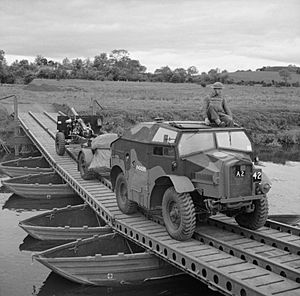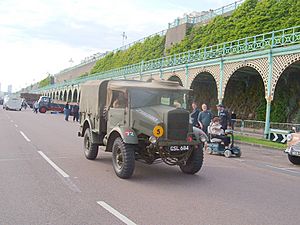Morris C8 facts for kids
Quick facts for kids Morris C8 Quad |
|
|---|---|

Morris-Commercial Quad, limber, and 25-pounder field gun crossing a pontoon bridge at Slaght Bridge in Antrim, Northern Ireland, 26 June 1942
|
|
| Type | Artillery tractor |
| Place of origin | United Kingdom |
| Production history | |
| Manufacturer | Morris and others |
| No. built | 10,000 |
| Specifications | |
| Mass | 3.3 long tons (3,400 kg) |
| Length | 14 ft 8+3⁄4 in (4.489 m) |
| Width | 7 ft 3 in (2.21 m) |
| Height | 7 ft 5 in (2.26 m) |
| Crew | 1 + 5 passengers |
|
|
|
| Armour | none |
| Engine | Morris EH, 4-cylinder 3.5 litre (214ci) petrol engine 70 bhp (52.2kW) |
| Suspension | Wheel, 4 x 4 |
|
Operational
range |
160 miles (257 km) |
| Maximum speed | 50 miles per hour (80 km/h) |
The Morris C8 Quad was a special kind of truck called an artillery tractor. It was used by the British army and other countries like Canada during World War II. Its main job was to pull big guns, like the powerful 25-pounder and 17-pounder cannons, across battlefields. Even though it looked tough with its sloped sides, the Quad wasn't armored, meaning it didn't have special protection against bullets.
Contents
How the Morris Quad Was Developed
Back in 1937, the British military needed a new, stronger vehicle to pull their cannons. They wanted something to replace older models like the Light Dragon. They asked for a new design: a four-wheel drive truck with a short base and a winch (a machine for pulling things).
Two companies, Guy Motors and Morris, came up with designs. Morris created a completely new design based on their Morris CS8 truck. It had a new four-cylinder engine. Like the Guy design, the Morris Quad had a unique "beetle-back" shape with sloped metal sides. This design made it easier to clean if there was a chemical attack. It also had a special spot on the roof to carry a gun platform.
The Morris Quad could carry six soldiers and lots of ammunition. It held 24 boxes of 25-pounder shells and at least 8 boxes of anti-tank shells.
The first Morris C8 Quad was ready in October 1939. It continued to be made until 1945. The engine and chassis design were also used for other Morris vehicles. A longer version was even used to make a special anti-aircraft gun tractor.
The Morris Quad in Action
The Morris Quad was a very important vehicle for artillery units. Each unit had 36 Quads. Some pulled a gun and a limber (a two-wheeled cart for carrying ammunition), while others pulled two limbers.
The Quad was first used in battle in France in 1940. It pulled 18-pounder and 4.5-inch howitzer guns. Many Quads were left behind during the Dunkirk evacuation, when British soldiers had to leave France quickly. Some of these captured Quads were then used by the German army.
From June 1940, the Quad also pulled 75mm guns that came from the USA. It was used wherever British and Commonwealth artillery units went, from cold Iceland to hot Malaya. Its main job was to pull the new 25-pounder gun. Many Allied countries also used the Quad.
Soldiers generally liked the Quad, but it was a bit small for all the gear they needed to carry. It also wasn't very powerful when fully loaded and pulling a heavy gun. Moving 9 tons with a 70 horsepower engine was tough, and it was slow going uphill. Soldiers often had to use the winch to help pull it up hills or through mud.
Later in the war, Quads were also used to pull anti-tank guns, like the 6-pounder and 17-pounder. These guns were usually pulled without a limber, as their ammunition didn't fit in it.
After World War II, the Quad continued to serve. It saw a lot of action in the Korean War and the Malayan Emergency. Many Commonwealth countries took their Quads home and even got more from Britain. The Royal Netherlands Army used them a lot in the East Indies.
The British army rebuilt many of their Quads in the early 1950s. This kept them in service until 1959, when they were finally sold off. Newer, larger tractors replaced them.
Different Types of Morris Quads
Over the years, the Morris Quad had a few different versions, called Marks.
Mark I Quad Details
Only about 200 Mark I Quads were made in 1939 and early 1940.
- The front axle could be locked for better grip.
- The axle was placed above the springs.
- It had permanent four-wheel drive.
- It used large 10.50 × 20 inch tires.
- The gas pedal was in the middle, not on the right side like most cars.
Mark II Quad Details
Around 4,000 Mark II Quads were made in 1940 and early 1941.
- It was very similar to the Mark I.
- The main difference was a change in the front axle design, which removed the locking feature.
Mark III Quad Details
About 6,000 Mark III Quads were made from 1941 to 1945.
- The front axle was placed below the springs.
- The four-wheel drive could be switched on or off.
- It used smaller 10.50 × 16 inch tires.
- The gas pedal was in the usual right-side position.
Body Styles of the Quad
The Morris Quad also had three different body styles:
- Early "Beetle Back" Body: All Mark Is and the first 3,000 Mark IIs had this. It had two doors, only two small windows on the right side, and one on the left. The roof was all metal with two spinning vents.
- Later "Beetle Back" Body: Used on later Mark IIs and the first 4,000 Mark IIIs. This version had an extra small window on the left front side and windows in both doors. It had a canvas roof over the crew area and two square vents behind it. These also had bigger fuel tanks.
- "Number 5 Body": The last 2,000 Mark IIIs had this new design. It was more square-shaped with a full canvas top and two round hatches. It also had four doors with windows.
Once the older 18-pounder guns were no longer used, there was no need to carry the gun's traversing platform on the roof. The brackets for it were removed. Often, a new frame was added to the roof to create more space for carrying equipment.
See also
- CMP FAT, a similar vehicle made by Chevrolet.


